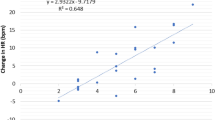Abstract
A radical behavioral model of pain is described in which pain is seen as the verbal description of the effects of a punisher. The verbal description behavior is learned when differential reinforcement is presented for certain kinds of self-talk about the effects of punishers. Depending on an individual’s history of experience, the verbal description may or may not have been learned to a particular kind of aversive stimulation. Pain response, thus, is expected to differ from person to person and punisher to punisher. In order to test these two notions, athletes and nonathletes were tested twice on two types of pain stimulation, cold pressor and ischemia. Between tests, participants were instructed in the use of a cognitive coping strategy in order to test if different coping abilities existed between groups. Results supported the radical behavioral model in that there was very little correlation between response to cold pressor and ischemia, and that different groups showed different tolerance and coping abilities. In general, female athletes had the highest pain tolerance and threshold on pretest and were able to use the coping strategy more effectively than the other groups. Discussion centers on further research designed to support the proposed model.
Similar content being viewed by others
References
BARBER, T.X. 1969. Hypnosis: A scientific approach. New York: Van Nostrand Reinhold.
BROWN, R.A., FADER, K., & BARBER, T.X. 1973. Responsiveness to pain: Stimulus-specificity versus generality. The Psychological Record, 23, 1–7.
CHAVES, J.R., & BARBER, T.X. 1974. Cognitive strategies, experimenter modeling, and expectation in the attenuation of pain. Journal of Abnormal Psychology, 83, 356-363.
DAVIDSON, P.O., & McDOUGALL, C.E. 1969. Personality and pain tolerance measures. Perceptual and Motor Skills, 28, 787–790.
GROSSBERG, J.M., & GRANT, B.F. 1978. Clinical psychophysics: Applications of signal detection methods to research in pain, fear, drugs, and medical decision making. Psychological Bulletin, 85, 1154–1176.
HILGARD, E.R., & HILGARD, J.R. 1975. Hypnosis in the relief of pain. Los Altos, CA.: William Kaufmann.
JAREMKO, M.E. 1978. Cognitive strategies in the control of pain tolerance. Journal of Behavior Therapy and Experimental Psychiatry, 9, 239–244.
JAREMKO, M.E. 1980. Cognitive-behavioral reflections on some dimensions of personality. Washington, D.C.: University Press of America.
LYNN, R., & EYSENCK, H.J. 1961. Tolerance for pain, extraversion, and neuroticism. Perceptual and Motor Skills, 12, 161–162.
KLEE, W.A. 1977. Endogenous opiate peptides. In H. Gainer (Ed.), Peptides in neurobiology. New York: Plenum.
MALOTT, R.W., & WHALEY, D.L. 1976. Psychology. New York: Harper and Row.
MEICHENBAUM, D. 1977. Cognitive-behavior modification. New York: Plenum.
MEICHENBAUM, D., & TURK, D. 1976. The cognitive-behavioral management of anxiety, anger, and pain. In P. Davidson (Ed.), The behavioral management of anxiety, depression, and pain. N.Y.: Brunner/Mazel.
MELZACK, R. 1973. The puzzle of pain. Harmondsworth, England: Penguin.
RACHMAN, S. 1976. The passing of the two-stage theory of fear: Fresh possibilities. Behavior Research and Therapy, 14, 125–131.
SKINNER, B.F. 1969. Contingencies of reinforcement: A theoretical analysis. Englewood Cliffs, N.J.: Prentice Hall.
SKINNER, B.F. 1974. About behaviorism. New York: Knopf.
TURK, D., MEICHENBAUM, D., & GENEST, M. 1980. Pain and behavioral medicine. New York: Guilford Press.
WEISENBERG, M. 1977. Pain and pain control. Psychological Bulletin, 84, 1008–1044.
WORTHINGTON, E. 1978. The content and function of imagery in controlling pain. Cognitive Therapy and Research, 2, 142–161.
Author information
Authors and Affiliations
Additional information
This research was supported by a grant from the University of Richmond Research Fund.
Rights and permissions
About this article
Cite this article
Jaremko, M.E., Silbert, L. & Mann, T. The Differential Ability of Athletes and Nonathletes to Cope With Two Types of Pain: A Radical Behavioral Model. Psychol Rec 31, 265–275 (1981). https://doi.org/10.1007/BF03394739
Published:
Issue Date:
DOI: https://doi.org/10.1007/BF03394739




